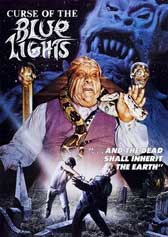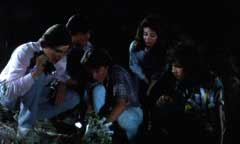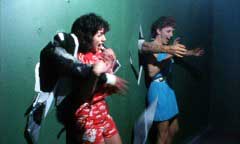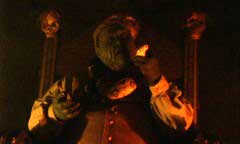 CURSE
OF THE BLUE LIGHTS (1988)
CURSE
OF THE BLUE LIGHTS (1988)Director: John Henry Johnson
Code Red Releasing
 CURSE
OF THE BLUE LIGHTS (1988)
CURSE
OF THE BLUE LIGHTS (1988)The long-forgotten Colorado-lensed regional horror flick CURSE OF THE BLUE LIGHTS is resurrected on DVD courtesy of Code Red Releasing.

The small town of Dudley’s local make-out point is nicknamed “The Blue Lights” for the sighting of the titular phenomena attributed variously to aliens and the ghosts of a century-old train wreck. One night college quartet Paul (Clayton A. McCaw), Sandy (Deborah McVencenty), Ken (Patrick Keller), and Alice (Becky Golladay) – along with would-be hot-rodders Max (Tom Massmann), Sam (James Asbury), and Bob (Kent E. Fritzell) – see the lights and decide to investigate. Wandering down to the edge of the river, they discover buried in the soil what they believe to be “The Muldoon Man”, either a statue likeness or the petrified remains of an ancient monster (named after the archaeologist who discovered it at the turn of the century before it disappeared in a tragic fire during its intended public exhibition). The septet decides to haul the ten-foot artifact out of the dirt and make some money off of it, but it disappears while they are getting a truck to haul it. The group follows the path the statue was dragged to the Sunny Hill Cemetery and the subterranean tunnels of its old crypt where they learn that the blue lights have marked the return to the area of Loath (Brent Ritter), leader of a ghoul clan whose birthright is to return The Muldoon Man back to life through the life fluids of innocent victims. When discovered, the seven barely escape with their lives; but Paul also has in his possession a small disc etched with incantations that is needed for the resurrection ceremony, so Loath sends his ghouls in pursuit. After two of their number mysteriously disappear, the survivors consult a witch (Bettina Julius) warns them of what will happen if The Muldoon Man is allowed to walk the Earth again.
 One
of the more ambitious regional horror flicks of the 1980s, CURSE OF THE BLUE
LIGHTS has in interesting production design (particularly Loath’s dungeon),
lighting, and make-up effects (courtesy of RETURN OF THE LIVING DEAD’s
Michael Spatola and THE RESURRECTED’s Mark Sisson) what it almost thoroughly
lacks in acting and storytelling. The film seems to have cast seven protagonists
less for monster fodder than so as to not burden any one of the cast members
with too much dialogue, with the only memorable performances coming from Ritter’s
ghoul (although more than a little of his dialogue is difficult to understand
with the distorted delivery) and Julius’ witch (also sometimes hard to
understand). The ghoul make-up is fairly accomplished while The Muldoon Man
looks a bit like the ice monster from CABIN BOY (1994), but the substance melted
down from the sacrifices and funneled into the creature’s mouth looks
like pork and beans (and actually is according to the commentary track). The
third act throws in an enthusiastic zombie horde (the featured zombies sporting
some good make-up while the rest seem consigned to the shadows and silhouettes),
a police shootout (utilizing Pueblo’s actual SWAT team), and a pyrotechnic
finale. The end product is no THE EVIL DEAD or PHANTASM – it’s actually
more like CURSE OF THE SCREAMING DEAD with some earnest attempts at production
value – but still entertaining and quite ambitious during a time when
flicks like these were all but supplanted on the video store shelf with endless
product from the likes of Troma and Corman’s New Concorde. Regional horror
fans owe it to themselves to seek this one out and encourage the rediscovery
of other examples.
One
of the more ambitious regional horror flicks of the 1980s, CURSE OF THE BLUE
LIGHTS has in interesting production design (particularly Loath’s dungeon),
lighting, and make-up effects (courtesy of RETURN OF THE LIVING DEAD’s
Michael Spatola and THE RESURRECTED’s Mark Sisson) what it almost thoroughly
lacks in acting and storytelling. The film seems to have cast seven protagonists
less for monster fodder than so as to not burden any one of the cast members
with too much dialogue, with the only memorable performances coming from Ritter’s
ghoul (although more than a little of his dialogue is difficult to understand
with the distorted delivery) and Julius’ witch (also sometimes hard to
understand). The ghoul make-up is fairly accomplished while The Muldoon Man
looks a bit like the ice monster from CABIN BOY (1994), but the substance melted
down from the sacrifices and funneled into the creature’s mouth looks
like pork and beans (and actually is according to the commentary track). The
third act throws in an enthusiastic zombie horde (the featured zombies sporting
some good make-up while the rest seem consigned to the shadows and silhouettes),
a police shootout (utilizing Pueblo’s actual SWAT team), and a pyrotechnic
finale. The end product is no THE EVIL DEAD or PHANTASM – it’s actually
more like CURSE OF THE SCREAMING DEAD with some earnest attempts at production
value – but still entertaining and quite ambitious during a time when
flicks like these were all but supplanted on the video store shelf with endless
product from the likes of Troma and Corman’s New Concorde. Regional horror
fans owe it to themselves to seek this one out and encourage the rediscovery
of other examples.

CURSE OF THE BLUE LIGHTS was released on videocassette by Magnum Entertainment in both rated (92:30) and unrated (95:13) – or “Original Uncensored Version” – editions. Code Red’s progressive, anamorphic widescreen (1.66:1) transfer is the R-rated version (92:30). The gore differences are actually slight other than a dissolving head and another head crushed by the Muldoon Man (although it’s a ghoul head so don’t expect the red stuff), roughly three minutes and sixteen seconds of the difference is actually the first scene after the opening teaser which shows Paul and Ken waiting in their car to pick up Sandy and Alice from school. This scene takes place during the daytime, whereas the R-rated version cuts from the teaser to the four already in the car travelling down the road at night (the commentators mention that this scene is missing, but not why it was removed from the R-rated cut). The transfer itself probably looks as good as the 16mm-lensed production can with its underlit or harshly lit night scenes, heavy color gel lighting and smoke diffusion. The scenes shot with saturated lighting (and the climax which might even have been shot with a colored filter in front of the lens itself) are more detailed than the Magnum release as expected, and it is easier to appreciate some of the film’s production design.
 The
disc’s most substantial extra is an audio commentary with director Johnson
and actor Ritter (who had already been working on the crew before being cast
in the lead) in which the director reveals that the “Blue Lights”
was an actual teenage parking area. Johnson had already cut his teeth as a filmmaker
with two TV documentaries on explorer Zebulon Pike – from whom Pike’s
Peak, Colorado is named – and writer Damon Runyon who grew up in Pueblo
and worked on his father’s newspaper before moving to New York. At the
time, he had a studio that had been a former post office package management
center with large spaces that allowed for shooting the car interior night scenes
on set as well as an entire cemetery set. The Victorian mansion was a happy
discovery with a photogenic exterior and fully-furnished interior, and several
of the major props – and lots of Kentucky Fried Chicken – were donated
by locals interested in the filmmaking process. Ritter recalls the make-up process
(six hours of make-up application before shooting), his aversion to vanilla-scented
fog after working on this film, and fills in some information on the cast members
and their subsequent careers. The disc also includes two still galleries with
over a hundred and twenty behind the scenes shots, script pages, close-ups of
props and set decorations, the ghouls and zombies in daylight, the production
office (including some shots from an elementary school tour), and promotional
images. The disc also includes trailers for JUST BEFORE DAWN, THE POLICE CONNECTION
(aka THE MAD BOMBER), DEATH MACHINES, and THE VISITOR. (Eric
Cotenas)
The
disc’s most substantial extra is an audio commentary with director Johnson
and actor Ritter (who had already been working on the crew before being cast
in the lead) in which the director reveals that the “Blue Lights”
was an actual teenage parking area. Johnson had already cut his teeth as a filmmaker
with two TV documentaries on explorer Zebulon Pike – from whom Pike’s
Peak, Colorado is named – and writer Damon Runyon who grew up in Pueblo
and worked on his father’s newspaper before moving to New York. At the
time, he had a studio that had been a former post office package management
center with large spaces that allowed for shooting the car interior night scenes
on set as well as an entire cemetery set. The Victorian mansion was a happy
discovery with a photogenic exterior and fully-furnished interior, and several
of the major props – and lots of Kentucky Fried Chicken – were donated
by locals interested in the filmmaking process. Ritter recalls the make-up process
(six hours of make-up application before shooting), his aversion to vanilla-scented
fog after working on this film, and fills in some information on the cast members
and their subsequent careers. The disc also includes two still galleries with
over a hundred and twenty behind the scenes shots, script pages, close-ups of
props and set decorations, the ghouls and zombies in daylight, the production
office (including some shots from an elementary school tour), and promotional
images. The disc also includes trailers for JUST BEFORE DAWN, THE POLICE CONNECTION
(aka THE MAD BOMBER), DEATH MACHINES, and THE VISITOR. (Eric
Cotenas)